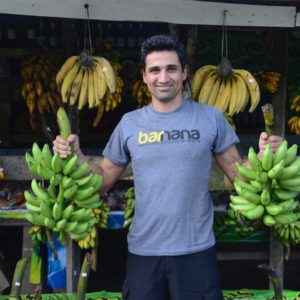Foodprints for the Future
The easiest thing you can do to help avoid climate catastrophe: Support upcycled foods
April 13, 2021
One of my best friends, Joe, loves to yank my chain and act like the climate crisis is far away in the future, completely the fault of the fossil fuel industry and so beyond his control that there’s nothing he can personally do to help. Unfailingly, I rise to the bait and remind him that even if he doesn’t buy an electric car or live in a yurt, the easiest thing each of us can do to reverse global warming is to reduce food waste, and the growing availability of upcycled foods makes it nearly effortless.
Food waste accounts for more than 8 percent of all human-made greenhouse gas emissions, making it a big contributor to climate change. According to the United Nations, if food waste were a country, it would be the world’s third-largest greenhouse gas emitter, only behind China and the U.S. Food is wasted all along its journey from the farm to our fridges, but solutions exist at every stage. Upcycling happens before a product gets to you.
There’s an important difference between recycling and upcycling products, and both are tools in the waste reduction fight. Recycling is the process of turning waste into a reusable product or material that’s most often of lesser value or quality than the original. Upcycling is different because it turns waste into a material or product that is of higher value than the original.
Take, for instance, the banana. My favorite food.
I grew up in Curitiba, Brazil, a city that pioneered eco-conscious urbanization, and retains its status as one of the world’s most sustainable cities. Throughout my childhood years my parents showed me the importance of leading a healthy lifestyle, starting with a macrobiotic diet as the foundation. My ever-resourceful dad hand built a solar-powered dehydrator to transform all types of fruits, including bananas, into healthy, chewy snacks. Years later at the age of 21, I moved to the United States to pursue my dream of becoming a professional triathlete. My training regime included fueling my body with the dehydrated banana snacks I had grown up on. Friends and training mates loved them just as much as I did, and that’s how the idea of creating Barnana first came to life.
Instead of seeing bananas discarded to landfill where they would emit harmful greenhouse gases that contribute to global warming, we upcycle them and create a value-added product. In this case, a delicious, nutritious snack made from dehydrated banana paste, puree and/or powder. An added benefit is that buying these bananas also supports the farmers, many of whom are from Indigenous communities, because it creates a secondary source of income.
So far, Barnana has upcycled more than 100 million bananas grown on small farms throughout Latin and Central America. This continued quest makes my parents proud because they understand the importance of working with smaller, independent farmers, and care about the planet and people throughout the supply chain.
While it’s encouraging to now see the upcycled foods movement gaining serious momentum, nimble disruptor brands like Barnana simply don’t have the scale to go it alone. The enormity of the climate crisis demands that these solutions be implemented by everyone, especially the largest players in the food system. Today, I read that a major global brewing company is investing $100 million into its U.S. operations, and hiring 50 new employees, to focus on a food upcycling effort. These exciting initiatives are being announced frequently.
I hope you’ll join me, my friend Joe (who’s now a food waste reduction champion) and others who happily support upcycled foods. For more information about upcycled foods, check out the Upcycled Food Association and tune in to my fireside chat with EARTHDAY.ORG’s Director of Food and Environment, Jillian Semaan, on April 22nd. Watch the second annual Earth Day Live for more workshops, panel discussions and performances about building a sustainable food system and this year’s Earth Day theme: Restore Our Earth.
Photo credit for image at top: Vanessa Loring from Pexels
